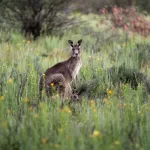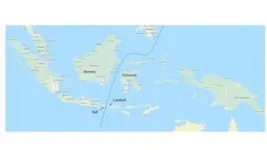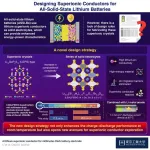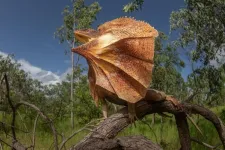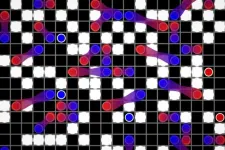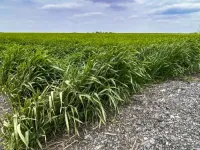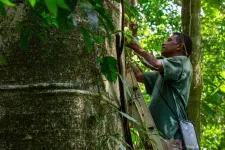(Press-News.org) Ask anyone what first springs to mind when they think of Australia and they’ll most likely say a kangaroo; the marsupial is ingrained in our national identity. But have you ever wondered why kangaroos never ventured beyond our shores?
A major study led by biologists at The Australian National University (ANU) and ETH Zurich in Switzerland provides a new explanation for why you won’t find kangaroos, koalas and other Aussie marsupials in Indonesia, but you will find many groups of animals that originated in Asia, such as goannas, rodents and kookaburras in Australia.
Biologists have long described this asymmetrical distribution of Australian and Asian species using an imaginary line that separates Australia, New Guinea and parts of Indonesia from continental Southeast Asia. This invisible boundary is known as Wallace’s Line.
In a new paper published in Science, the researchers say changing plate tectonics and a dramatic shift in Earth’s climate tens of millions of years ago are the reasons for the uneven distribution of Australian and Asian creatures on both sides of the invisible boundary -- finally providing an explanation for the enigma of Wallace’s Line, which has long baffled scientists.
The ANU researchers found species that originated in Asia could tolerate a wide variation in climactic conditions and were more successful at adapting to and settling in Australia, which explains why there is more Asian fauna found in Australia compared to the other way around.
“If you travel to Borneo, you won't see any marsupial mammals, but if you go to the neighboring island of Sulawesi, you will. Australia, on the other hand, lacks mammals typical of Asia, such as bears, tigers or rhinos,” Dr Alex Skeels, from ANU, said.
According to Dr Skeels, this uneven distribution of animal species on both sides of Wallace’s Line is partly due to changes in ancient plate tectonics -- dating back 45 million years -- that ultimately led to a “continental collision” that altered the geographic composition of Earth.
“About 35 million years ago, Australia was located much further south and was connected to Antarctica,” he said.
“At some point in Earth’s timeline, Australia broke away from Antarctica and over millions of years drifted north, causing it to crash into Asia. That collision gave birth to the volcanic islands that we now know as Indonesia.”
The islands of Indonesia served as “stepping stones” for animals and plants that originated in Asia to reach New Guinea and northern Australia, and vice versa.
“Our research shows far more groups of Asian fauna crossed over and established themselves in Australia than in the opposite direction,” Dr Skeels said.
But as ANU researchers explain, a shift in plate tectonics is just one piece of the puzzle in explaining the migration of Asian species to Australia. When Australia broke away from Antarctica, there was a climactic shift that led to a trend of global cooling and drying of the continents, which led to mass extinction events around the world.
“When Australia drifted away from Antarctica, it opened up this area of Deep Ocean surrounding Antarctica which is now where the Antarctic Circumpolar Current is. This dramatically changed Earth’s climate as a whole; it made the climate much cooler,” Dr Skeels said.
“Despite this global cooling, the climate on the Indonesian islands, which organisms used as a gateway to hop to Australia, remained relatively warm, wet and tropical. So Asian fauna were already well adapted and comfortable with these conditions, so that helped them settle in Australia.
“This was not the case for the Australian species. They had evolved in a cooler and increasingly drier climate over time and were therefore less successful in gaining a foothold on the tropical islands compared to the creatures migrating from Asia.”
The researchers analysed a dataset of about 20,000 birds, mammals, reptiles and amphibians to determine which species hopped between Indonesia and Australia, and which ones were able to successfully adapt to their new home.
“Our findings could also inform predictions for animal migration in the future and help us predict which species may be better versed at adapting to new environments, as changes to Earth’s climate continues to impact global biodiversity patterns,” Dr Skeels said.
END
Why you won’t see kangaroos in Java but you will find goannas in Australia
2023-07-06
ELSE PRESS RELEASES FROM THIS DATE:
New design rule for high-entropy superionic solid-state conductors
2023-07-06
Solid electrolytes with high lithium-ion conductivity can be designed for millimeter-thick battery electrodes by increasing the complexity of their composite superionic crystals, report researchers from Tokyo Tech. This new design rule enables the synthesis of high-entropy active materials while preserving their superionic conduction.
As the world transitions towards a greener and more sustainable energy economy, reliance on lithium (Li)-ion batteries is expected to rise. Scientists from across the globe are working towards designing smaller yet efficient batteries that can keep up with the ever-increasing demand for energy ...
Why there are no kangaroos in Bali (and no tigers in Australia)
2023-07-06
If you travel to Bali, you won’t see a cockatoo, but if you go to the neighbouring island of Lombok, you will. The situation is similar with marsupials: Australia is home to numerous marsupial species, such as the kangaroo and the koala. The further west you go, the sparser they become. While you will find just two representatives of these typically Australian mammals on the Indonesian island of Sulawesi, you will search in vain for them on neighbouring Borneo. Australia, on the other hand, is not home to mammals that you will typically find in Asia, such as bears, tigers ...
MIT physicists generate the first snapshots of fermion pairs
2023-07-06
CAMBRIDGE, Mass. -- When your laptop or smartphone heats up, it’s due to energy that’s lost in translation. The same goes for power lines that transmit electricity between cities. In fact, around 10 percent of the generated energy is lost in the transmission of electricity. That’s because the electrons that carry electric charge do so as free agents, bumping and grazing against other electrons as they move collectively through power cords and transmission lines. All this jostling generates friction, and, ultimately, heat.
But when electrons pair up, they can rise above the fray and glide through a material without ...
Prize winner reveals how commensal-derived “silent” flagellins evade innate immunity
2023-07-06
Sara Clasen is the 2023 winner of the NOSTER & Science Microbiome Prize for her work in illuminating how “silent flagellins” from commensal microbiota evade a host’s innate immunity.
The NOSTER & Science Microbiome Prize aims to reward innovative research from young investigators working on the functional attributes of the microbiota of any organism that has potential to contribute to our understanding of health and disease, or to guide novel therapeutic interventions.
Strong adaptive immune responses require activation of innate immunity. To do this, innate ...
Researchers demonstrate first visible wavelength femtosecond fiber laser
2023-07-06
WASHINGTON — Researchers have developed the first fiber laser that can produce femtosecond pulses in the visible range of the electromagnetic spectrum. Fiber lasers producing ultrashort, bright visible-wavelength pulses could be useful for a variety of biomedical applications as well as other areas such as material processing.
Visible femtosecond pulses are usually obtained using complex and inherently inefficient setups. Although fiber lasers represent a very promising alternative due to their ruggedness/reliability, small footprint, efficiency, lower cost and high brightness, it hasn’t been possible, until now, to produce visible pulses with durations in the femtosecond ...
Top corn producing state to see future drop in yield, cover crop efficiency
2023-07-06
URBANA, Ill. — Winter cover crops could cut nitrogen pollution in Illinois’ agricultural drainage water up to 30%, according to recent research from the University of Illinois Urbana-Champaign. But how will future climate change affect nitrogen loss, and will cover crops still be up to the job? A new study investigating near- and far-term climate change in Illinois suggests cover crops will still be beneficial, but not to the same degree. The report also forecasts corn ...
New study: Black women with hypertensive disorders of pregnancy have increased stroke risk
2023-07-06
(Boston) – U.S. Black women have a disproportionately higher burden of both preeclamptic pregnancy and stroke compared with white women, but virtually all existing evidence on the association between the two medical conditions has come from studies of white women.
A newly published study focuses on data gathered over 25 years from 59,000 Black women in the Black Women’s Health Study (BWHS) and is led by researchers from Boston University Chobanian & Avedisian School of Medicine and Slone Epidemiology Center. The study, published in the New England Journal of Medicine Evidence, ...
Bezos Earth Fund grants $12 million to Smithsonian to support major forest carbon project
2023-07-06
By conserving and replanting forests, the world buys time until it brings other climate and sustainability solutions online. As a critical step toward this goal, the Smithsonian Tropical Research Institute (STRI) received a $12 million grant from the Bezos Earth Fund to support GEO-TREES. This international consortium is the first worldwide system to independently ensure the accuracy of satellite monitoring of forest biomass—a way to measure carbon stored in trees—in all forest types and conditions. The GEO-TREES alliance offers a freely accessible database that integrates ...
Legends of Norse Settlers drove Denmark towards Greenland
2023-07-06
In 985, Viking explorer Erik the Red led a group of Icelandic farmers to Greenland, where they established a settlement on the west coast. Archaeological evidence suggests that the settlement existed for over 400 years, but the impact of the settlement lasted much longer. It is little recognised today that the hope of finding the descendants of the settlers dominated European and American perspectives on Greenland for centuries
In his new book The Vanished Settlers of Greenland: In Search of a Legend and Its Legacy, Associate Professor Robert Rix argues that the lost Norse settlement played a decisive ...
Archaeology: The power of the Copper Age 'Ivory Lady' revealed
2023-07-06
The highest status individual in ancient Copper Age society in Iberia, was a woman and not a man as previously thought, according to peptide analysis reported in Scientific Reports. The individual, now re-dubbed the 'Ivory Lady', was buried in a tomb filled with the largest collection of rare and valuable items in the region, including ivory tusks, high-quality flint, ostrich eggshell, amber, and a rock crystal dagger. These findings reveal the high status women could hold in this ancient society.
In 2008, an individual was discovered in a tomb in Valencia, Spain dating to the Copper Age between 3,200 and 2,200 years ago. As well as being a rare example of a single occupancy ...
